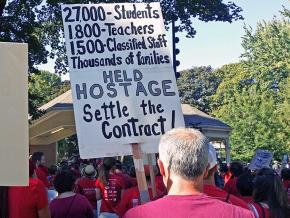Picket lines get the goods
reports on the teachers’ strikes in southwestern Washington.
WASHINGTON STATE teachers are demonstrating again what the “red state” teachers’ revolt showed earlier this year: Strikes get the goods.
Washington’s “hot autumn” follows the resolution of a decade-long legal battle over the state’s failure to adequately fund its public school system. In order to comply with a ruling by the Washington Supreme Court, state legislators added $2 billion to the state budget specifically to pay for teachers’ salaries.
But school officials in many districts across the state dragged their feet in using the money for its intended purpose of giving teachers a much-deserved raise. As Darrin Hoop put it in a recent article for SW, “[M]any district administrations around the state, especially those in southwestern Washington, want to hoard the funds, either for bloated administrator’s salaries, other general education funding needs or to put towards reserve funds for future ‘crises.’”
So teachers took matters in their own hands, kicking off a mini-strike wave that started in the southwestern corner of the state and is only now beginning to wind down.

Three districts — Centralia, Tumwater, and Tacoma — were still out on strike as this article was being written on September 10. Washougal schools started on September 7. Evergreen and Longview teachers voted on tentative agreements on September 9. As we went to press, teachers in Battle Ground were still at the negotiating table, and they were mobilizing along with their supporters to pack a school board meeting on September 10.
ON FRIDAY, September 7, several thousand teachers, supporters from unions like SEIU and the Teamsters, groups like Jobs with Justice, students and classified staff gathered for a rally in support of striking teachers past and future in Esther Short Park in Vancouver, across from Portland, Oregon over Washington’s southern border.
Throngs of teachers and their supporters flowed through downtown Vancouver clad in red. They shared stories about time spent on the picket lines, forging new networks and friendships based on the solidarity of standing together for education justice.
Teachers from all over southern Washington — those who had just won contracts as well as those still in negotiations — addressed the crowd. Battle Ground teachers drove through downtown in a giant pick-up truck decorated with shiny red flags reminiscent of Dorothy’s red slippers in The Wizard of Oz.
The park itself turned into a sea of red shirts, flags and picket signs emblazoned with the names of different teachers’ unions, reading “Fair contract now!” or “On strike!” And then there were the handmade signs adorned with snarky memes or calling out stingy superintendents like Evergreen Superintendent John Steach with his $230,000 salary.
One student held a sign that said, “Investing in our teachers means investing in our future. Doctors, engineers, physicists, teachers, lawyers, politicians, CSI, biologists, etc. Now tell me why teachers don’t deserve fair pay?”
Alaia R., a high school senior at Vancouver’s Hudson Bay High School not far from Esther Park, came across the rally by accident. “I don’t get why more of my classmates don’t think this is amazing,” she said. Another sign simply stated, “Putting my feet down to lift schools up!”
As strike leaders and union officials, including Washington Education Association President Kim Mead, spoke from the stage, the crowd became jubilant.
“This isn’t just a fight for a fair contract but about fighting for dignity,” said one teacher. “How many times has a student asked you if they should go into our profession and you told them not to? We should be able to recommend our profession to our students.”
Many parents have supported the strikers by joining picket lines, donating their time in other ways, and contributing to the stockpile of materials necessary to keep the strikes running.
Whatever hardships may be caused by school closures, parents know firsthand how much teachers do for their kids. And for those without access to alternative child care, part-time staff at schools on strike have been volunteering to watch children.
As Erin, who is on strike at Shahala Middle School. explained:
Not only do parents have to find childcare, teachers who are out striking have to as well. I was commenting to someone that I would happily work for childcare wages if that’s what people want. That means I get $10 an hour per kid. I have 32 kids in class so that is $320 per hour. I happen to be part time. I work four classes a day instead of five in the middle school. Four classes a day is $1,280, if my math is right. We work 180 days for the school year, which works out to be $230,400.
Support staff, classified staff, office workers and Clark College all have contract battles coming up. And though most of the strikes are winding down, the lessons remain fresh in everyone’s minds: you can win when solidarity is the key weapon.


